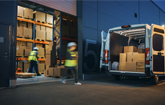NEW YORK, Jan. 14, 2025 /PRNewswire/ -- Report with the AI impact on market trends - The returnable transport packaging market in north america size is estimated to grow by USD 977.3 million from 2025-2029, according to Technavio. The market is estimated to grow at a CAGR of 6.5% during the forecast period. Increased demand for modern grocery retailing is driving market growth, with a trend towards increased adoption of returnable transport packaging. However, high initial investment and operational cost poses a challenge. Key market players include Amatech Inc., Brambles Ltd., Cartonplast Group GmbH, DHL Express Ltd., DS Smith Plc, Georg Utz Holding AG, Greif Inc., Knauf Digital GmbH, Menasha Corp., Myers Industries Inc., NEFAB GROUP, Rehrig Pacific Co., Schoeller Allibert, Signode Industrial Group LLC, Sonoco Products Co., SSI Schafer IT Solutions GmbH, Tosca Services LLC, and Weir and Carmichael Ltd..
Key insights into market evolution with AI-powered analysis. Explore trends, segmentation, and growth drivers- View Free Sample PDF
Returnable Transport Packaging Market In North America Scope |
|
Report Coverage |
Details |
Base year |
2024 |
Historic period |
- |
Forecast period |
2025-2029 |
Growth momentum & CAGR |
Accelerate at a CAGR of 6.5% |
Market growth 2025-2029 |
USD 977.3 million |
Market structure |
Fragmented |
YoY growth 2022-2023 (%) |
6.1 |
Regional analysis |
North America |
Performing market contribution |
North America at 100% |
Key countries |
US, Canada, and Mexico |
Key companies profiled |
Amatech Inc., Brambles Ltd., Cartonplast Group GmbH, DHL Express Ltd., DS Smith Plc, Georg Utz Holding AG, Greif Inc., Knauf Digital GmbH, Menasha Corp., Myers Industries Inc., NEFAB GROUP, Rehrig Pacific Co., Schoeller Allibert, Signode Industrial Group LLC, Sonoco Products Co., SSI Schafer IT Solutions GmbH, Tosca Services LLC, and Weir and Carmichael Ltd. |
Market Driver
The Returnable Transport Packaging market is witnessing significant trends in various industries, including transportation, building & construction, and trading. Lightweight and eco-friendly packaging solutions are in high demand due to their economic benefits and value for money. The use of returnable crates, containers, pallets, and drums in logistics is increasing, reducing single-use packaging waste and transportation costs. The construction materials segment, including wood and plastic, is a major consumer of returnable transport packaging. Logistics service providers are focusing on security and in-transit damage protection for hazardous materials, such as chemicals and paints, using durable materials like metal, plastic, and wood. The plastic segment, including plastic pallets and drums, is gaining popularity due to its cost-effectiveness and protection level. Urbanization and industrial activities are driving the demand for sustainable packaging, such as biomass-based and biodegradable raw materials. The economic benefits of recycling and reusing returnable packaging are also attracting businesses to adopt these solutions. The cold chain sector is another significant user of returnable transport packaging for efficient and sustainable supply chain management. The environmental impact of packaging waste is a growing concern, and businesses are looking for eco-friendly alternatives to single-use packaging. Technological innovations in returnable transport packaging, such as reusable containers and pallets made from eco-friendly plastics, are gaining popularity due to their sustainability goals and cost-effectiveness. In conclusion, the Returnable Transport Packaging market is witnessing significant trends towards sustainability, cost-effectiveness, and efficiency. The use of returnable packaging solutions is reducing single-use packaging waste, transportation costs, and environmental impact while providing protection and security for various industries.
The demand for returnable transport packaging is anticipated to rise due to increasing environmental consciousness. Compared to disposable packaging like cardboard pallets, reusable transport packaging reduces carbon dioxide emissions by 28-30%. This investment is cost-effective in the long run as the expense is recouped through multiple uses. Returnable transport packaging is also more stable than disposable packaging, minimizing the risk of damage during handling and transportation.
Request Sample of our comprehensive report now to stay ahead in the AI-driven market evolution!
Market Challenges
- The Returnable Transport Packaging Market faces several challenges in various industries such as transportation, trading, building & construction, and logistics. These challenges include the need for lightweight and value-for-money solutions, minimizing wastage, and ensuring security during transportation of trading goods like construction materials, chemical, tools, and hazardous materials. Eco-friendly packaging solutions are increasingly preferred due to their economic benefits and recycling capabilities. Logistics service providers require returnable crates, pallets, and containers to optimize their operations and reduce transportation costs. Single-use packaging waste is a significant concern, especially in urbanization and industrial activities. The construction industry relies on wood segment for packaging, but it's not always sustainable. Plastic segments like plastic crates, drums, and pallets offer cost-effective in-transit damage protection for various products, including paints, consumer durables, and automotive. Efficiency and sustainability goals are crucial in the cold storage chain, where eco-friendly plastics, biomass, and biodegradable raw materials are preferred. Technological innovations in returnable transport packaging, such as metal, high-density polypropylene, and synthetic plastics, offer durable solutions for various industries. The environmental impact of packaging waste and negative environmental impact of disposable incomes, energy consumption, and volatile prices necessitate a shift towards sustainable packaging solutions like reusable packaging and recyclable packaging. The supply chain management and shipping process benefit from these solutions, reducing costs and increasing efficiency.
- The returnable transport packaging market involves an initial investment that is greater than traditional disposable packaging systems. This higher cost is due to the rental and procurement expenses associated with returnable packaging. The investment required depends on the length of the shipment value chain, which includes the time spent shipping to the transporter, at the receiver, and returning the container, as well as any cleaning and sorting processes involved. Despite the initial cost, businesses may benefit from the long-term cost savings and sustainability advantages of returnable transport packaging.
Discover how AI is revolutionizing market trends- Get your access now!
Segment Overview
This returnable transport packaging market in North America report extensively covers market segmentation by
- End-user
- 1.1 Food and beverage
- 1.2 Manufacturing
- 1.3 Retail and consumer
- Geography
- 2.1 North America
- Product
- 3.1
1.1 Food and beverage- The North American returnable transport packaging market is witnessing growth due to the expanding food and beverage industry. With the rise in demand for packaged food products among consumers, there is an increase in the consumption of paper and paper board packaging materials. The food and beverage sector, followed by manufacturing, is driving the market's growth. Reusable materials, such as glass bottles and aluminum cans, dominate the market share for food and beverage packaging. The meat and poultry industry and grocery stores segment are also experiencing growth due to increased production and complex supply chains. However, the COVID-19 pandemic negatively impacted the market in 2020 due to temporary closures of food processing businesses and low investments. The lifting of lockdowns and resumption of essential business operations have led to a gradual recovery in the food industry, driving the market's growth during the forecast period. Food and beverage manufacturers, distributors, and related industries hold significant market share, with a rise in the purchasing power of the middle class fueling demand. Companies are focusing on manufacturing eco-friendly and cost-effective packaging solutions to meet the increasing demand for small portion meals and sustainable packaging.
Download a Sample of our comprehensive report today to discover how AI-driven innovations are reshaping competitive dynamics
Research Analysis
The returnable transport packaging market is witnessing significant growth due to the increasing focus on sustainability and reducing the environmental impact of packaging. Reusable packaging, a key component of this market, is gaining popularity as it promotes a circular economy by reducing waste and the need for constant production of new packaging. Sustainable materials, such as renewable and biodegradable options, are being used to create durable and eco-friendly packaging solutions. Packaging regulations are driving the need for optimization and innovation in the market. Packaging software and design tools help companies create efficient and cost-effective packaging solutions, while logistics optimization and supply chain efficiency are also important considerations. Packaging technology, such as automation and recycling, is advancing to meet the demands of the market. The circular economy is a major trend in the market, with a focus on reducing carbon footprint and waste through reuse and recycling. Green logistics and eco-friendly solutions are becoming increasingly important as energy prices rise and environmental regulations become stricter. The packaging lifecycle is being closely examined to identify opportunities for waste reduction and supply chain sustainability. Non-biodegradable materials are facing increasing scrutiny, and companies are turning to sustainable alternatives to meet consumer demand for eco-friendly options. The market is also seeing innovation in compostable and biodegradable packaging solutions, as well as the use of recycled materials in new packaging designs. Overall, the returnable transport packaging market is evolving to meet the needs of a more sustainable and eco-conscious world.
Market Research Overview
The returnable transport packaging market is a significant segment of the transportation industry, focusing on providing cost-effective and eco-friendly solutions for moving goods between trading entities. This market encompasses various types of packaging, including returnable crates, pallets, drums, and containers, which offer value for money through their reusability and durability. Building & construction, chemical, and automotive industries are major consumers of returnable packaging solutions due to the heavy and bulky nature of their products. Lightweight and recyclable materials, such as high-density polypropylene and plastic, are increasingly popular in this market due to their economic benefits and sustainability goals. However, the use of wood and metal in returnable packaging is still prevalent, especially in industries with specific requirements for security and protection against fungal growth or hazardous materials. Logistics service providers play a crucial role in the supply chain management of returnable transport packaging, ensuring efficient transportation and in-transit damage protection. The market also faces challenges such as wastage, trading costs, and the negative environmental impact of single-use packaging waste. Technological innovations, such as biodegradable raw materials and eco-friendly plastics, are driving the market towards more sustainable packaging solutions. Consumer income, urbanization, and the environmental mandate are also key factors influencing the growth of the returnable transport packaging market. The market caters to various industries, including construction materials, consumer durables, industrial activities, and the cold chain, among others. The cost of products, transportation, and production are essential considerations for businesses in this market. In summary, the returnable transport packaging market offers durable and cost-effective solutions for various industries, with a focus on sustainability and reducing the environmental impact of packaging waste. Logistics service providers play a crucial role in ensuring efficient and secure transportation, while technological innovations continue to drive the market towards more eco-friendly and cost-effective packaging solutions.
Table of Contents:
1 Executive Summary
2 Market Landscape
3 Market Sizing
4 Historic Market Size
5 Five Forces Analysis
6 Market Segmentation
- End-user
- Food And Beverage
- Manufacturing
- Retail And Consumer
- Geography
- North America
- Product
7 Customer Landscape
8 Geographic Landscape
9 Drivers, Challenges, and Trends
10 Company Landscape
11 Company Analysis
12 Appendix
About Technavio
Technavio is a leading global technology research and advisory company. Their research and analysis focuses on emerging market trends and provides actionable insights to help businesses identify market opportunities and develop effective strategies to optimize their market positions.
With over 500 specialized analysts, Technavio's report library consists of more than 17,000 reports and counting, covering 800 technologies, spanning across 50 countries. Their client base consists of enterprises of all sizes, including more than 100 Fortune 500 companies. This growing client base relies on Technavio's comprehensive coverage, extensive research, and actionable market insights to identify opportunities in existing and potential markets and assess their competitive positions within changing market scenarios.
Contacts
Technavio Research
Jesse Maida
Media & Marketing Executive
US: +1 844 364 1100
UK: +44 203 893 3200
Email: [email protected]
Website: www.technavio.com/
SOURCE Infiniti Research, Inc.

WANT YOUR COMPANY'S NEWS FEATURED ON PRNEWSWIRE.COM?
Newsrooms &
Influencers
Digital Media
Outlets
Journalists
Opted In






Share this article